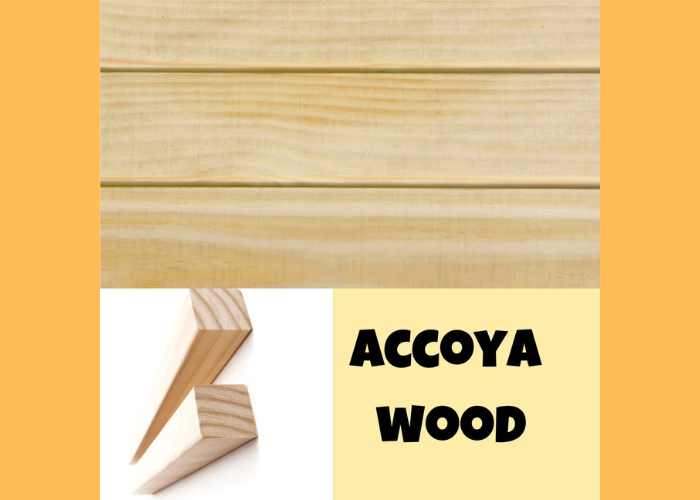Accoya Wood
What is Accoya Wood?
One breakthrough kind of modified wood with great durability, stability, and adaptability is accoya wood. It is created by a chemical process known as acetylation, which improves the natural attributes of the wood and qualifies for many uses including doors, windows, cladding, and decking.
History and Development of Accoya Wood:
Origins and Early Development
Foundational Research: Accoya wood started its path in the 1970s and 1980s under concentration on softwood performance improvement. The aim was to produce a substance that might match the stability and strength of conventional hardwoods.
Acetylation Process: The breakthrough came with the discovery of acetylation, a chemical process altering the cell structure of the wood. This technique substitutes acetyl groups for free hydroxyl groups in wood by treating it with acetic anhydride. This change significantly reduces the wood’s moisture absorption, therefore improving its stability and durability.
Commercial Production: Accsys Technologies, a Dutch-based company, started commercial manufacturing of Accoya wood in 2007. Fast-growing softwoods were turned into premium Accoya wood in Arnhem, Netherlands, the first manufacturing plant.
Growth and Recognition
Global Expansion: Accoya wood became well-known for its better properties after first success. To satisfy increasing demand in North America, a second manufacturing plant built in Kingsport, Tennessee, USA This development let this wood be more easily accessible on several markets.
Sustainability Credentials: This wood has been certified by groups such the Forest Stewardship Council (FSC) and Cradle to Cradle Gold accreditation for Material Health due to its efforts toward sustainability. Since it is also the only building material with Cradle to Cradle Platinum accreditation, it emphasizes even more its environmental awareness.
Also read: Why Cypress Wood is Your Best Choice !
How Accoya Wood is Manufactured

Acetylation is a specialized technique used in production of Accoya wood that greatly improves its qualities, thereby improving its durability, stability, and environmental sustainability. The production process has several main stages:
1. Selection of Timber:
Fast-growing, sustainable softwoods including Douglas Fir, Western Red Cedar, and Southern Pine make up most of Accoya wood. These species are chosen for their availability and suitability for the acetylation process.
2. Drying the Wood:
The chosen wood is dried to very low moisture content before the acetylation process starts. This stage is absolutely important since it helps avoid any moisture-related problems during the acetylation and ready the wood for efficient treatment.
3. Acetylation Process
Accoya’s manufacture is based mostly on the acetylation process, which consists in many sub-steps:
Soaking in Acetic Anhydride: The dry wood is submerged in acetic anhydride, a chemical that interacts with its cellular structure.
Chemical Reaction: Acetyl groups replace free hydroxyl groups—which absorb water—to change the cell walls of the wood. This change helps the wood not absorb moisture, hence lowering swelling and shrinkage.
Removal of Residual Chemicals: After the chemical reaction, any residual acetic anhydride and byproducts are removed from the wood.
4. Quality Control
After treatment, the acetylated wood is thoroughly tested to guarantee it satisfies high performance criteria. These include evaluations of general integrity, stability, and durability.
5. Recycling By-products
The production process is designed to be environmentally friendly:
Recycling Acetic Anhydride: Every wasted acetic anhydride is recycled for next rounds of manufacture.
Utilization of By-products: Acetic acid, the primary reaction’s byproduct, is sold raw to many other sectors.
6. Final Product
Following quality inspection, Accoya wood is ready for use in windows, doors, decking, and cladding among other uses. Its improved qualities fit for indoor and outdoor surroundings.
Properties:
1. Durability
Rot Resistance: Class 1 durability of this wood makes it quite resistant to rot and decay, which qualifies it for outdoor usage without the need of poisonous preservatives
Long Warranty: Reflecting its long-lasting performance, lengthy warranties of up to 50 years above ground and 25 years in ground or freshwater applications abound.
2. Stability
Minimal Movement: This wood is made to withstand noticeable deformation, shrinkage, and swelling. Applications like windows and doors depend on this stability; dimensional integrity is therefore absolutely vital.
Weather Resistance: Particularly helpful for outdoor construction, it resists severe weather and preserves its form and appearance over time.
3. Sustainability
Eco-Friendly Sourcing: Accoya wood is obtained sustainably by means of FSC-certified forests, so guaranteeing environmental friendliness. Its minimal carbon footprint in manufacturing helps to create a circular bio-based economy.
Non-Toxic: At the end of its life cycle, the acetylation process makes Accoya wood non-toxic, safe for humans and animals, and totally biodegradable.
4. Performance
Enhanced Thermal Insulation: Improved thermal insulating qualities of Accoya, as compared to conventional woods, can result in energy savings in buildings.
Longer Coating Life: The durability of the wood lets coatings and finishes stick better and last longer, therefore lowering over time maintenance requirements.
5. Versatility
Design Freedom: This wood offers architects and designers significant versatility in their projects by allowing them to finish it in unique sizes and several textures (smooth, burnt, brushed).
Wide Range of Applications: Strong qualities of this material make it appropriate for many uses including cladding, decking, windows, doors, and outdoor furniture.
Disadvantages of Accoya Wood
Known for its superior qualities resulting from the acetylation process, accoya wood has certain disadvantages. Its drawbacks are written out in great depth here.
1. Cost

Because of the specific manufacturing method, Accoya wood often costs more than conventional softwoods and some hardwoods. Projects on a tight budget may find this disappointing.
2. Limited Availability
Depending on the area, Accoya could not be as easily accessible as other kinds of wood, hence project lead times could be higher.
3. Weight
Because Accoya wood can be heavier than other substitutes, in some uses stronger structural support may be needed.
4. Surface Treatment Needs
Accoya is stable, but it still needs suitable surface treatments—such as staining or sealing—to keep its look over time, particularly if used outside.
5. Perception of Modified Wood
Because of ideas about authenticity or worries about the chemical manufacturing techniques used, some customers might want natural timbers instead of modified choices.
Also read: Is Poplar Wood Right for You? Find Out!
FAQs
1. What makes Accoya Wood different from regular wood?
Acetylation transforms this wood in such that it is more stable, durable, and decay-resistant than untreated wood.
2. Is Accoya Wood environmentally friendly?
Exactly. Made from sustainably sourced timber, it employs a non-toxic modification technique under certifications including FSC and Cradle to Cradle.
3. Can Accoya Wood be painted or stained?
Of course! Accoya leaves a smooth, long-lasting gloss by effectively absorbing paint and stain.
4. What is the lifespan of Accoya Wood?
One of the toughest wood choices available, it may survive 25 years below ground and over 50 years above ground.
5. Where can I buy Accoya Wood?
It is available via distributors and specialist timber suppliers. For availability, check internet or call nearby wood stores.
Also read: Ziricote Wood: Advantages and Disadvantages

